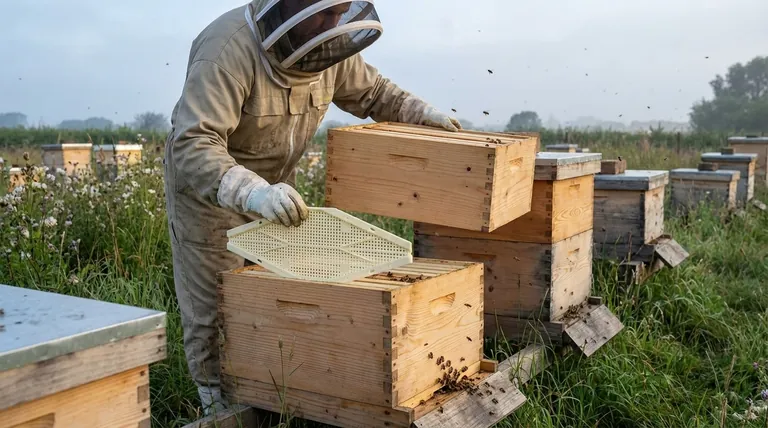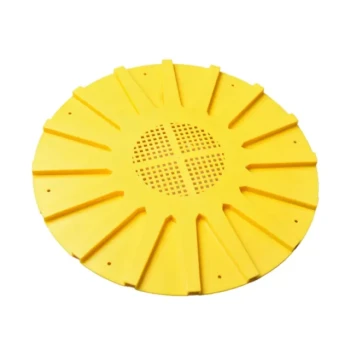To use a triangle escape board effectively, you must install it during cooler temperatures when bees naturally move downward toward the brood box. The board should be placed directly beneath the honey supers you intend to harvest, with the triangle side facing down. Leave it in place for approximately 24 hours to allow most bees to exit the super.
A triangle escape board is a tool for a patient beekeeper. Its success hinges on leveraging the bees' natural downward movement while strictly adhering to a 24-hour time limit to prevent them from finding a way back in.

How the Triangle Escape Board Achieves a Calm Harvest
A triangle escape board is a simple but ingenious device designed to clear bees from honey supers with minimal stress to the colony. Understanding its mechanism is key to using it correctly.
A One-Way Journey for Bees
The board features a maze-like design with one or more triangular openings. This construction creates a simple path for bees to travel down and out of the honey super but makes it extremely difficult for them to navigate their way back up.
Leveraging Natural Bee Behavior
The board's design works in concert with the bees' natural instincts. Bees, especially during cooler evening and morning temperatures, have a tendency to move downward in the hive to cluster in the brood nest. The escape board simply provides an easy, one-way route for this journey.
A Step-by-Step Guide to Proper Use
Correct installation and timing are not just recommendations; they are requirements for the board to function as intended.
Step 1: Choose the Right Time
Plan your harvest for a period of cooler weather. This encourages the bees' downward migration, making the board significantly more effective. Avoid using it during intense heat or major nectar flows.
Step 2: Position the Board Correctly
The escape board acts as a divider. It must be placed directly below the honey super(s) you wish to harvest and above the brood boxes or any supers you are leaving on the hive.
Step 3: Critical Orientation
The orientation is the most crucial step. The side with the triangle openings must face DOWN, toward the brood box. The flat, solid surface of the board must face UP, toward the honey super you are clearing. This directs the bees out and prevents re-entry.
Step 4: Seal All Other Entrances
Before you walk away, ensure the honey super is well-sealed. Any cracks, gaps, or other entrances will become a new doorway for bees to get back in, completely defeating the purpose of the escape board.
Understanding the Trade-offs and Common Pitfalls
While highly effective when used properly, the escape board is not a perfect solution and has clear limitations. Misunderstanding these can lead to a failed harvest attempt.
The 24-Hour Rule is Not Flexible
The board should be left on the hive for no more than 24 hours in most conditions. In colder weather, this can sometimes be extended to 48 hours. If left longer, the bees will eventually figure out how to bypass the maze and return to the honey.
Brood in the Super Stops Everything
The escape board will not work if there is brood (bee eggs, larvae, or pupae) in the honey super. Nurse bees are biologically programmed to care for the young and will not abandon them. If you have brood in your supers, you must address that colony issue first.
It Won't Be 100% Empty
Set realistic expectations. The escape board will remove a vast majority of the bees—often around 80% or more—but you should still expect some stragglers. Always wear your protective gear when removing the supers.
Making the Right Choice for Your Goal
Use this tool when your goals align with its strengths.
- If your primary focus is a gentle, stress-free harvest: The escape board is an excellent choice, as it passively clears bees without chemicals, smoke, or forceful brushing.
- If your primary focus is speed: Be aware of the 24 to 48-hour waiting period; this method is not for an immediate harvest.
- If you suspect there is brood in your honey supers: Do not use an escape board, as it will be ineffective and you must first resolve why your queen is laying in the wrong area.
Properly used, the triangle escape board allows for a calm and efficient harvest that respects the well-being of your colony.
Summary Table:
| Key Factor | Optimal Condition |
|---|---|
| Temperature | Cooler weather (evening/morning) |
| Timing | Leave in place for 24 hours (max 48 in cold) |
| Placement | Directly below honey super, above brood box |
| Orientation | Triangle openings face DOWN |
| Prerequisite | No brood present in the honey super |
Achieve a gentler, more efficient harvest with the right equipment. The triangle escape board is a cornerstone of patient, bee-friendly beekeeping. HONESTBEE supplies commercial apiaries and beekeeping equipment distributors with high-quality, durable beekeeping supplies through our wholesale-focused operations. Let us equip your operation for success. Contact HONESTBEE today to discuss your wholesale needs and ensure your next harvest is calm and productive.
Visual Guide

Related Products
- High-Efficiency Diamond Maze Bee Escape for Clearing Supers
- HONESTBEE Wooden Bee Escape Board with Triangle Mesh Design for Beekeeping
- HONESTBEE Multi Exit Plastic Bee Escape Board for Efficient Honey Harvesting
- Circular Labyrinth Bee Escape for Efficient Hive Management
- Efficient Hive Clearing: HONESTBEE 8-Way Plastic Bee Escape
People Also Ask
- How long should a bee escape be placed before harvesting honey? The 24-48 Hour Guide to a Stress-Free Harvest
- How long should the Bee Escape Board be left on the honey supers? Achieve a Peaceful Harvest in 24 Hours
- What is a bee escape and why is it used in beekeeping? A Guide to Gentle Honey Harvesting
- What happens if Triangular Escape Boards are left on for more than 24 hours? Risk of Bee Re-Entry and Failed Harvest
- Where should the Bee Escape board be placed? For a Calm, Bee-Free Honey Harvest



















